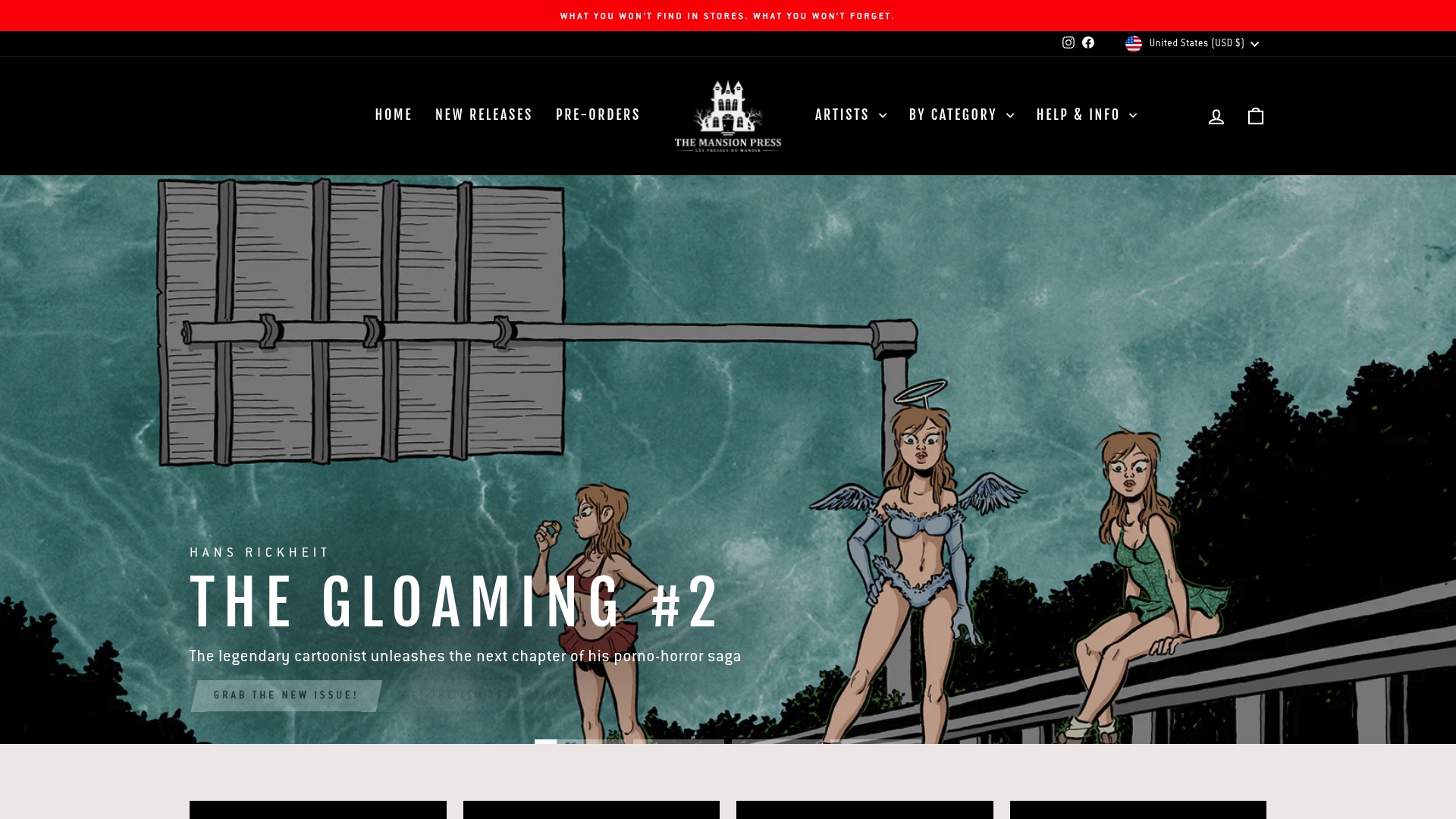Complete Guide to Dark Visual Storytelling
More than 60 percent of acclaimed graphic novels use dark visual storytelling to evoke deep emotional responses. This approach pulls viewers into intense worlds where shadows, symbols, and distorted forms speak louder than words. Whether you are a curious reader, an artist, or a collector, understanding these visual techniques reveals how powerful art can challenge, unsettle, and move us beyond the ordinary.
Key Takeaways
| Point | Details |
|---|---|
| Emotional Communication | Dark visual storytelling employs strategic visual techniques to convey complex emotional experiences. |
| Subgenre Diversity | The genre includes subgenres like Psychological Noir and Gothic Horror, each exploring unique themes and symbolism. |
| Visual Techniques | Techniques such as tenebrism and symbolic color theory enhance narrative depth and emotional resonance. |
| Ethical Responsibility | Artists must maintain ethical considerations when exploring intense themes to avoid trivializing profound human experiences. |
Table of Contents
- Defining Dark Visual Storytelling Techniques
- Major Types And Subgenres Explained
- Core Visual Elements And Narrative Devices
- Common Themes And Symbolism In Dark Storytelling
- Essential Tips For Collectors And Artists
- Risks, Missteps, And Creative Ethics
Defining Dark Visual Storytelling Techniques
Dark visual storytelling represents a sophisticated narrative approach that transforms graphic art from mere illustration into profound emotional communication. According to research on dark graphic novels, these techniques employ multiple strategic visual elements to create intense psychological landscapes.
At its core, dark visual storytelling leverages several critical techniques:
- Tenebrism: A dramatic lighting technique where extreme light and shadow contrasts create emotional tension
- Monochromatic Palettes: Using limited color ranges to amplify mood and psychological depth
- Distorted Perspectives: Warping visual planes to represent internal emotional states
- Symbolic Imagery: Embedding hidden meanings within visual compositions
As art historians have documented, the tenebrism approach specifically manipulates illumination to generate extraordinary narrative impact. Darkness becomes more than background – it transforms into an active storytelling element that communicates psychological complexity without requiring explicit dialogue.
The power of dark visual storytelling lies in its ability to communicate profound emotional experiences through strategic visual manipulation. By transforming traditional graphic representation, artists create immersive narratives that speak directly to viewers’ subconscious, transcending typical storytelling boundaries.
Major Types and Subgenres Explained
Dark visual storytelling encompasses multiple complex subgenres that challenge traditional narrative conventions. According to research on dark graphic novels, these genres are characterized by profound narrative complexity and deliberate deconstruction of traditional storytelling archetypes.
The primary subgenres of dark visual storytelling include:
- Psychological Noir: Exploring inner mental landscapes through fragmented, nonlinear narratives
- Gothic Horror: Utilizing supernatural themes with intense symbolic imagery
- Dystopian Narrative: Presenting bleak societal landscapes that challenge human perception
- Existential Dark Fantasy: Merging philosophical questioning with surreal visual metaphors
Dark fantasy visuals, in particular, employ specific symbolic strategies. As research indicates, they use iconic motifs like full moons, ravens, and pentagrams to create immediate visual shorthand for uncanny themes. These symbols work alongside dramatic light and shadow techniques to instantly communicate complex emotional landscapes.
Each subgenre represents a unique approach to storytelling, transforming graphic art from simple illustration into a sophisticated medium of psychological exploration. By breaking traditional narrative structures, these visual stories invite viewers to engage with deeper, often uncomfortable aspects of human experience.

Here’s a summary of dark visual storytelling subgenres and their defining features:
![]()
| Subgenre | Key Themes | Signature Visual Elements |
|---|---|---|
| Psychological Noir | Mental conflict Nonlinear time |
Fragmented layouts Distorted views |
| Gothic Horror | Supernatural Symbolism |
Dramatic shadows Ornate imagery |
| Dystopian Narrative | Oppression Bleak landscapes |
Stark color Urban decay |
| Existential Dark Fantasy | Philosophy Absurdity |
Surreal scenes Fantasy motifs |
Core Visual Elements and Narrative Devices
Visual storytelling transforms narrative experience through sophisticated artistic techniques that communicate beyond traditional text. According to research on visual narrative techniques, artists deploy multiple strategic elements to create immersive emotional landscapes.
Key narrative devices include:
- Chiaroscuro: A dramatic lighting technique using extreme light and shadow contrasts
- Symbolic Color Theory: Using color palettes to communicate psychological states
- Negative Space: Employing emptiness to create tension and emotional depth
- Fragmented Composition: Breaking traditional panel structures to represent psychological complexity
As research from chiaroscuro studies indicates, this technique employs strong light and dark contrasts to model volume and focus audience attention. The interplay between illumination and shadow becomes a narrative language, conveying mood and dramatic emphasis without requiring explicit explanation.
Color theory emerges as another powerful storytelling mechanism. According to color psychology research, warm tones suggest energy or danger, while cool tones evoke calm and mystery. These chromatic choices do more than decorate – they guide audience perception, define character emotional states, and reinforce underlying symbolic meanings. By strategically manipulating visual elements, artists transform graphic storytelling from mere illustration into a profound communication medium.
Common Themes and Symbolism in Dark Storytelling
Dark storytelling transcends mere visual representation, serving as a profound medium for exploring complex human experiences. According to research on dark comic themes, these narratives courageously address societal taboos, moral complexity, and psychological vulnerabilities.
Symbolic elements in dark storytelling frequently manifest through powerful archetypal imagery:
- Broken Mirrors: Representing fragmented identity and internal conflict
- Skulls: Symbolizing mortality, transience, and existential contemplation
- Shadows: Embodying psychological darkness, repressed emotions
- Labyrinths: Metaphors for psychological complexity and emotional journeys
Dark art symbolism strategically employs these powerful visual metaphors to communicate profound psychological states. These symbols function as visual shorthand, allowing artists to communicate intricate emotional landscapes without relying solely on traditional narrative techniques.
By confronting challenging themes like trauma, oppression, and existential dilemmas, dark storytelling encourages critical reflection and deep empathy. These narratives transform uncomfortable psychological territories into accessible visual experiences, inviting audiences to explore the nuanced, often unexpressed dimensions of human emotional experience.
Essential Tips for Collectors and Artists
Dark visual storytelling offers profound opportunities for both creators and collectors to explore complex emotional landscapes. For those interested in building a meaningful collection, understanding the deeper psychological dimensions is crucial.
Key considerations for artists and collectors include:
- Emotional Authenticity: Prioritize works that genuinely explore psychological complexity
- Compositional Mastery: Study Notan principles of light and dark balance
- Symbolic Depth: Select pieces with multilayered narrative potential
- Cultural Context: Understand the broader psychological and social implications
According to research on dark art, these works provide significant therapeutic and cultural value by enabling exploration of challenging emotions and confronting societal norms. The Notan principle, specifically, helps artists structure compelling visual narratives through strategic light and dark interactions, creating powerful compositional balance.
For collectors, dark visual storytelling represents more than aesthetic acquisition—it’s an opportunity to engage with profound human experiences. By carefully selecting works that demonstrate sophisticated emotional intelligence and technical mastery, artists and collectors contribute to a nuanced dialogue about human complexity, transforming visual art into a profound medium of psychological exploration.
Risks, Missteps, and Creative Ethics
Dark visual storytelling demands extraordinary creative responsibility, balancing intense emotional exploration with profound ethical considerations. According to expert perspectives on creative practices, artists must navigate complex terrain where psychological depth can easily transform into problematic representation.
Critical ethical considerations include:
- Intentional Symbolism: Ensuring visual metaphors serve narrative purpose
- Trauma Representation: Avoiding sensationalism when depicting difficult experiences
- Audience Emotional Impact: Maintaining sensitivity to potential viewer triggers
- Narrative Integrity: Preventing gratuitous shock value
Research suggests that misusing dark storytelling techniques risks alienating audiences or trivializing profound human experiences. Creators must approach intense themes with nuanced understanding, recognizing that powerful visual narratives require thoughtful, deliberate symbolic deployment.
The most effective dark visual storytelling emerges from a place of genuine empathy and critical self-reflection. By maintaining a delicate balance between emotional intensity and narrative purpose, artists can transform potentially exploitative imagery into meaningful explorations of human complexity, creating work that challenges without overwhelming, and illuminates without causing additional psychological harm.
Transform Your Dark Storytelling Vision into a Tangible Collection
Are you looking to bring the profound emotion and symbolic complexity of dark visual storytelling into your personal artbook collection? Many readers struggle to find exclusive works that embody deep techniques like tenebrism and psychological noir, or that display the kind of narrative discipline discussed in our guide. The challenge often lies in finding authentic pieces that go beyond surface illustration, offering true narrative depth and artistic craftsmanship that resonates on a personal level.

Experience for yourself how The Mansion Press bridges this gap. Browse our unique artbooks, comics, and limited editions inspired by the very principles covered in the guide. Every selection is crafted in collaboration with groundbreaking independent artists, ensuring emotional authenticity and symbolic richness. Discover your next masterpiece or pre-order a highly anticipated release. Visit The Mansion Press now and secure artwork that challenges the boundaries of visual storytelling before these rare editions disappear.
Frequently Asked Questions
What are the key techniques used in dark visual storytelling?
Dark visual storytelling employs techniques such as tenebrism, monochromatic palettes, distorted perspectives, and symbolic imagery to create emotional depth and psychological complexity.
What are some common subgenres of dark visual storytelling?
Common subgenres include psychological noir, gothic horror, dystopian narratives, and existential dark fantasy, each exploring unique themes and utilizing specific visual strategies.
How does color theory play a role in dark visual storytelling?
Color theory is essential in dark visual storytelling, where warm tones can evoke energy or danger, and cool tones suggest calm and mystery, guiding audience perception and reinforcing emotional themes.
What ethical considerations should artists keep in mind when creating dark visual narratives?
Artists should ensure their symbolism is intentional, avoid sensationalizing trauma, remain sensitive to viewer emotional impact, and maintain narrative integrity to prevent gratuitous shock value.
Recommended
- Dark Visual Storytelling Tips for Underground Comics – The Mansion Press
- Understanding Dark Graphic Novels Explained – The Mansion Press
- Understanding Visual Narrative: The Art of Storytelling – The Mansion Press
- Understanding Exploring Dark Comics Themes for Art Lovers – The Mansion Press
- Understanding Visual Content Marketing: Key Concepts Explained

